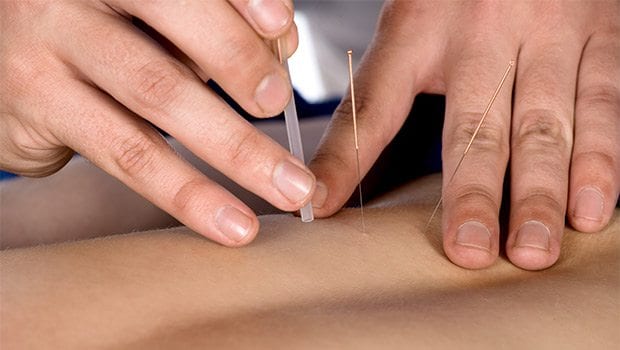Acupuncture: A common remedy for low back pain
A 2,000-year-old treatment in modern times

It’s a little odd that the relatively new kid on the block in mainstream medicine in this country is actually 2,000 years old. Acupuncture, a form of traditional Chinese medicine, is transitioning from alternative medicine to a staple in many U.S. clinics and medical practices.
At the core of acupuncture is the belief that life force, or energy called qi (“chee”) flows through 14 basic pathways called meridians. “There are 300 points on the body connected by these meridians,” explained professor

Author: Photo courtesy Bing YangBing Yang, chair of the Chinese Herbal Medicine Department at the New England School of Acupuncture, MCPHS University
Bing Yang, chair of the Chinese Herbal Medicine Department at the New England School of Acupuncture, MCPHS University. “Stops along these meridians are connected with each other in a network of energy points.”
When something goes amiss in the body it is believed that there is a blockage in qi that causes stagnation in the flow of energy. If the qi flows freely, there is no pain; if the qi is blocked, pain ensues. The purpose of acupuncture is to break up the blockage. Hair-thin needles are used to penetrate the skin in order to promote the flow of energy. The choice of size and length of the needle depends largely on body type and the extent of the disease, Yang explained.
In addition, various techniques are applied to enhance results. For instance, in tonifying and dispersing techniques the needles are rotated and thrust differently. Moxibustion uses an herb called moxa to stimulate the flow of qi. The herb is burned close to, but not on, the insertion point. Patients feel a sense of warmth, but the smell of the moxa is not a fan favorite.
Cupping is a technique that uses suction cups for the desired effect. “Cupping is used for muscle pain,” Yang explained. It is believed that the blood has stagnated, and the cupping actually draws a small amount of blood, but in so doing, allows new blood circulation. It leaves its telltale mark, as noted on the back of Michael Phelps during the recent Olympics.
Although acupuncture is associated more with relief of pain, it is actually used for several different ailments. The World Health Organization in 2003 developed a list of more than 40 conditions for which acupuncture can be used. The list might surprise you: Depression, rheumatoid arthritis and even drug addiction are examples. Most common is low back pain, such as herniated discs and spinal stenosis. “Acupuncture helps with inflammation,” Yang explained.
The theory behind acupuncture is that it stimulates the brain to release endorphins, the body’s natural pain-killing chemicals. It may also stimulate the production of serotonin, which controls mood. In other words, it stimulates the body to heal itself.
Acupuncture is not boilerplate treatment. There is no established protocol, explained Yang. Although a patient comes with a “Western” diagnosis, such as herniated disc, the treatment will vary by body type and symptoms. Generally, once the needles have been inserted, they stay in place for about a half hour. Often six to 10 sessions is considered one course of treatment.
Yang readily accepts that not everyone will respond to acupuncture. Emotions may play a role. People suffering from depression take longer, as well as people who are over-thinkers. “In general, older and weaker people are slower to respond because it takes more time to improve the flow of qi,” she said. Also, those who continue to have chronic low back pain after surgery might not get the desired results in comparison to those who have not had surgery for the same condition.
Acupuncture has its share of naysayers. But Yang is not buying it. Nor is the National Center for Complementary and Integrative Health. In a recent report published in Mayo Clinic Proceedings, randomized clinical trials found that acupuncture and yoga were effective for chronic low back pain. But the 14 million people who have used acupuncture already know that.






